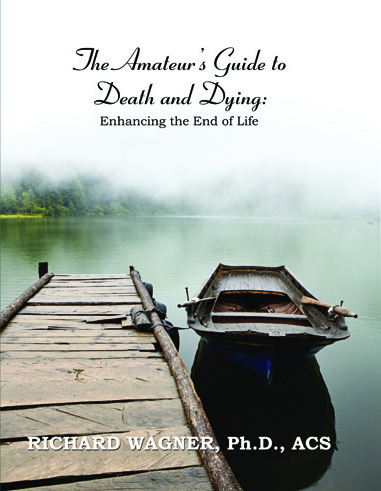Marian Ronan:
The Amateur’s Guide to Death and Dying: Enhancing the End of Life, by Richard Wagner, Ph.D. Las Vegas, NV: Nazca Plains, 2012. 431 pp.
Well, it’s happening. The baby-boomers are becoming senior citizens. I joined Medicare and got my half-price MTA card in April. My husband has retired and we’re planning a trip to Paris.
But getting older isn’t all sweetness and light. Even as Keith and I are packing, my best friend from college has checked into a hospice in Toronto, her metastatic breast cancer exploding throughout her body. Ten or twenty years ago I would have characterized this as a catastrophe. Increasingly, it’s the new normal.
Apparently we Americans put a lot of energy into avoiding this “darker” side of getting older. Clinical psychologist Richard Wagner (actually I’m a psychotherapist, clinical sexologist) has extensive experience helping people to come to terms with their own deaths and the deaths of those they love, so he’s written a workbook for the rest of us: The Amateur’s Guide to Death and Dying.
The chapters of The Amateur’s Guide are structured around ten sessions of the death and dying support groups that the author leads professionally in Northern California. Ten fictional group members, composites of actual participants, interact with one another, telling their stories, and engaging the material that Wagner and other experts present. Forms are also provided for us, the readers, to respond to the materials, provide feedback, even evaluate the contents and process of the workshop.
Among the death and dying-related subjects the book/workshop addresses are fear and avoidance of the reality of death, dealing with regrets and old wounds, end-of -life documents and preparations like advance directives, wills and trusts, who to notify, distribution of your possessions, etc., spirituality in death and dying, sexuality and intimacy in the dying process, and what someone’s last weeks and days are actually like.
Reading the responses of the various group members to the presentations and assignments helps to make this material real. But doing the assignments yourself makes death and dying all the more palpable. I was surprised at how deeply moved—and disturbed—I was as I did the various exercises, for example, writing my own obituary and describing the last weeks and days of my own life. This may not be true for everyone, but for me, engaging the prospect of my death was a sobering experience. But I feel I am better for it.
No book is perfect, of course. For the first half of the book, I found it almost impossible to keep the ten members of the group straight in my head. I finally made a crib sheet with the name, age, and a brief description of each, which I printed out and kept inside the front cover. The publisher should send out a bookmark with such information on it when someone buys a copy of The Amateur’s Guide so that readers can consult it as each group member begins to “talk.” The book is also pretty large—the cover is eight by ten inches and the book is an inch thick—which made it hard for me to take on the subway, where I do a lot of my reading.
But this is quibbling. The Amateur’s Guide to Death and Dying makes a valuable contribution to helping readers come to terms with an aspect of life that too many of us tend to avoid. Grail groups around the country would do well to use it to help members begin—or continue—to deal with the reality of death
Marian Ronan blog: An American Catholic on the Margins of World Christianity.


